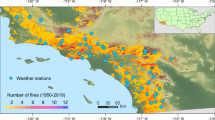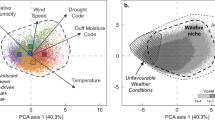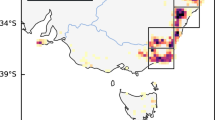Abstract
California has experienced enhanced extreme wildfire behaviour in recent years1,2,3, leading to substantial loss of life and property4,5. Some portion of the change in wildfire behaviour is attributable to anthropogenic climate warming, but formally quantifying this contribution is difficult because of numerous confounding factors6,7 and because wildfires are below the grid scale of global climate models. Here we use machine learning to quantify empirical relationships between temperature (as well as the influence of temperature on aridity) and the risk of extreme daily wildfire growth (>10,000 acres) in California and find that the influence of temperature on the risk is primarily mediated through its influence on fuel moisture. We use the uncovered relationships to estimate the changes in extreme daily wildfire growth risk under anthropogenic warming by subjecting historical fires from 2003 to 2020 to differing background climatological temperatures and aridity conditions. We find that the influence of anthropogenic warming on the risk of extreme daily wildfire growth varies appreciably on a fire-by-fire and day-by-day basis, depending on whether or not climate warming pushes conditions over certain thresholds of aridity, such as 1.5 kPa of vapour-pressure deficit and 10% dead fuel moisture. So far, anthropogenic warming has enhanced the aggregate expected frequency of extreme daily wildfire growth by 25% (5–95 range of 14–36%), on average, relative to preindustrial conditions. But for some fires, there was approximately no change, and for other fires, the enhancement has been as much as 461%. When historical fires are subjected to a range of projected end-of-century conditions, the aggregate expected frequency of extreme daily wildfire growth events increases by 59% (5–95 range of 47–71%) under a low SSP1–2.6 emissions scenario compared with an increase of 172% (5–95 range of 156–188%) under a very high SSP5–8.5 emissions scenario, relative to preindustrial conditions.
This is a preview of subscription content, access via your institution
Access options
Access Nature and 54 other Nature Portfolio journals
Get Nature+, our best-value online-access subscription
$29.99 / 30 days
cancel any time
Subscribe to this journal
Receive 51 print issues and online access
$199.00 per year
only $3.90 per issue
Buy this article
- Purchase on Springer Link
- Instant access to full article PDF
Prices may be subject to local taxes which are calculated during checkout




Similar content being viewed by others
Data availability
The Weather Research and Forecasting model used for the predictor data (Supplementary Information 3) is an open source and can be downloaded from GitHub (https://github.com/wrf-model/WRF/releases). MODIS fire products that were used for the predictand data (Supplementary Information 2) can be downloaded from FIRMS (https://firms.modaps.eosdis.nasa.gov/active_fire/) and the CMIP6 climate model data (Supplementary Information 4) can be downloaded from IPCC WGI Interactive Atlas (https://interactive-atlas.ipcc.ch/regional-information). Source data are provided with this paper.
Code availability
The code for this study is archived at GitHub (https://github.com/ptbrown31/Climate-Driven-Risk-of-Extreme-Wildfire-in-California).
References
Coop, J. D. et al. Extreme fire spread events and area burned under recent and future climate in the western USA. Glob. Ecol. Biogeogr. 31, 1949–1959 (2022).
Juang, C. S. et al. Rapid growth of large forest fires drives the exponential response of annual forest-fire area to aridity in the western United States. Geophys. Res. Lett. 49, e2021GL097131 (2022).
Keeley, J. E. & Syphard, A. D. Large California wildfires: 2020 fires in historical context. Fire Ecol. 17, 22 (2021).
Wang, D. et al. Economic footprint of California wildfires in 2018. Nat. Sustain. 4, 252–260 (2021).
Bowman, D. M. J. S. et al. Human exposure and sensitivity to globally extreme wildfire events. Nat. Ecol. Evol. 1, 0058 (2017).
Starrs, C. F., Butsic, V., Stephens, C. & Stewart, W. The impact of land ownership, firefighting, and reserve status on fire probability in California. Environ. Res. Lett. 13, 034025 (2018).
Bowman, D. M. J. S. et al. Vegetation fires in the Anthropocene. Nat. Rev. Earth Environ. 1, 500–515 (2020).
Seneviratne, S. I. et al. in Climate Change 2021: The Physical Science Basis. Contribution of Working Group I to the Sixth Assessment Report of the Intergovernmental Panel on Climate Change (eds Masson-Delmotte, V. et al.), pp. 1513–1766 (Cambridge Univ. Press, 2021).
Mandel, J. et al. Recent advances and applications of WRF–SFIRE. Nat. Hazards Earth Syst. Sci. 14, 2829–2845 (2014).
Rabin, S. S. et al. The Fire Modeling Intercomparison Project (FireMIP), phase 1: experimental and analytical protocols with detailed model descriptions. Geosci. Model Dev. 10, 1175–1197 (2017).
Goss, M. et al. Climate change is increasing the likelihood of extreme autumn wildfire conditions across California. Environ. Res. Lett. 15, 094016 (2020).
Williams, A. P. et al. Observed impacts of Anthropogenic climate change on wildfire in California. Earths Future 7, 892–910 (2019).
Abatzoglou, J. T. & Williams, A. P. Impact of anthropogenic climate change on wildfire across western US forests. Proc. Natl Acad. Sci. USA 113, 11770–11775 (2016).
Seager, R. et al. Climatology, variability, and trends in the U.S. vapor pressure deficit, an important fire-related meteorological quantity. J. Appl. Meteorol. Climatol. 54, 1121–1141 (2015).
Jolly, W. M. et al. Climate-induced variations in global wildfire danger from 1979 to 2013. Nat. Commun. 6, 7537 (2015).
van Oldenborgh, G. J. et al. Attribution of the Australian bushfire risk to anthropogenic climate change. Nat. Hazards Earth Syst. Sci. 21, 941–960 (2021).
Abatzoglou, J. T., Williams, A. P. & Barbero, R. Global emergence of Anthropogenic climate change in fire weather indices. Geophys. Res. Lett. 46, 326–336 (2019).
Jain, P., Castellanos-Acuna, D., Coogan, S. C. P., Abatzoglou, J. T. & Flannigan, M. D. Observed increases in extreme fire weather driven by atmospheric humidity and temperature. Nat. Clim. Change 12, 63–70 (2022).
Wang, S. S.-C., Qian, Y., Leung, L. R. & Zhang, Y. Identifying key drivers of wildfires in the contiguous US using machine learning and game theory interpretation. Earths Future 9, e2020EF001910 (2021).
Huang, Y., Jin, Y., Schwartz, M. W. & Thorne, J. H. Intensified burn severity in California’s northern coastal mountains by drier climatic condition. Environ. Res. Lett. 15, 104033 (2020).
Elia, M. et al. Estimating the probability of wildfire occurrence in Mediterranean landscapes using Artificial Neural Networks. Environ. Impact Assess. Rev. 85, 106474 (2020).
Satir, O., Berberoglu, S. & Donmez, C. Mapping regional forest fire probability using artificial neural network model in a Mediterranean forest ecosystem. Geomat. Nat. Hazards Risk 7, 1645–1658 (2016).
Werth, P. A. et. al. Synthesis of Knowledge of Extreme Fire Behavior: Volume 2 for Fire Behavior Specialists, Researchers, and Meteorologists. General Technical Report PNW-GTR-891 (U.S. Department of Agriculture, Forest Service, Pacific Northwest Research Station, 2016).
Schär, C., Frei, C., Lüthi, D. & Davies, H. C. Surrogate climate-change scenarios for regional climate models. Geophys. Res. Lett. 23, 669–672 (1996).
Patricola, C. M. & Wehner, M. F. Anthropogenic influences on major tropical cyclone events. Nature 563, 339–346 (2018).
Otto, F. E. L. Attribution of weather and climate events. Annu. Rev. Environ. Resour. 42, 627–646 (2017).
French, N. H. F., Kasischke, E. S. & Williams, D. G. Variability in the emission of carbon-based trace gases from wildfire in the Alaskan boreal forest. J. Geophys. Res. 108, FFR 7-1–FFR 7-11 (2003).
Flannigan, M. D., Logan, K. A., Amiro, B. D., Skinner, W. R. & Stocks, B. J. Future area burned in Canada. Clim. Change 72, 1–16 (2005).
Conard, S. G. et al. Determining effects of area burned and fire severity on carbon cycling and emissions in Siberia. Clim. Change 55, 197–211 (2002).
Potter, B. E. & McEvoy, D. Weather factors associated with extremely large fires and fire growth days. Earth Interact. 25, 160–176 (2021).
Gutierrez, A. A. et al. Wildfire response to changing daily temperature extremes in California’s Sierra Nevada. Sci. Adv. 7, eabe6417 (2021).
Philip, S. et al. A protocol for probabilistic extreme event attribution analyses.Adv. Stat. Climatol. Meteorol. Oceanogr. 6, 177–203 (2020).
Bindoff, N. L. et al. in Climate Change 2013: The Physical Science Basis. Contribution of Working Group I to the Fifth Assessment Report of the Intergovernmental Panel on Climate Change (ed. Stocker, T. F.), pp. 857–952 (Cambridge Univ. Press, 2013).
Duane, A., Castellnou, M. & Brotons, L. Towards a comprehensive look at global drivers of novel extreme wildfire events. Clim. Change 165, 43 (2021).
Woollings, T. et al. Blocking and its response to climate change. Current Clim. Change Rep. 4, 287–300 (2018).
Swain, D. L. A shorter, sharper rainy season amplifies California wildfire risk. Geophys. Res. Lett. 48, e2021GL092843 (2021).
Zhuang, Y., Fu, R., Santer, B. D., Dickinson, R. E. & Hall, A. Quantifying contributions of natural variability and anthropogenic forcings on increased fire weather risk over the western United States. Proc. Natl Acad. Sci. 118, e2111875118 (2021).
Stephens, S. L. et al. Drought, tree mortality, and wildfire in forests adapted to frequent fire. BioScience 68, 77–88 (2018).
Westerling, A. L. Increasing western US forest wildfire activity: sensitivity to changes in the timing of spring. Philos. Trans. R. Soc. B Biol. Sci. 371, 20150178 (2016).
Ma, W. et al. Assessing climate change impacts on live fuel moisture and wildfire risk using a hydrodynamic vegetation model. Biogeosciences 18, 4005–4020 (2021).
Acknowledgements
San José State’s Wildfire Interdisciplinary Research Center (WIRC) is supported by the National Science Foundation (NSF)’s Industry–University Cooperative Research Center (IUCRC) Program (award number 2113931). We thank the Pacific Gas and Electric Meteorology Operations and Fire Science team for useful discussion throughout the project. We acknowledge the teams at DTN (https://www.dtn.com/), Atmospheric Data Solutions (http://www.atmosphericdatasolutions.com/) and Sonoma Technology (http://www.sonomatech.com/) for data collection and preprocessing. We also acknowledge M. Voss for technical support and A. J. Eiserloh, R. Bagley and P. Pall for valuable discussions. This project was partially funded by a contract (C6909) between the San José State University Research Foundation and Pacific Gas and Electric titled ‘Understanding Extreme Fire Weather Conditions Using a 30-Year High-Resolution WRF Model Dataset’. A.M. was supported by the Director, Office of Science, Office of Biological and Environmental Research of the US Department of Energy as part of the Regional and Global Model Analysis program area within the Earth and Environmental Systems Modeling Program under contract number DE-AC02-05CH11231.
Author information
Authors and Affiliations
Contributions
S.J.S. introduced P.T.B. and H.H. to the broad conceptual framework used in this study (using machine learning models to predict the risk of extreme wildfire growth), and P.T.B. and H.H. worked together to refine the conceptual framework for climate-change-related applications. P.T.B. conceived of the specific methodology of the study, performed all the analyses and wrote an initial draft of the paper. A.M. and C.R. contributed to the technical and philosophical aspects of the machine learning experiment design and validation. S.J.D. created a schematic for Fig. 1 and helped refine communication (including figure design) throughout the study. A.K.K. and C.B.C. provided domain expertise in wildfire science, advising on which predictor variables to use. P.T.B., H.H., A.M., C.R., S.J.S., S.J.D., AKK. and C.B.C. all contributed to the interpretation of results and refinement of the manuscript.
Corresponding author
Ethics declarations
Competing interests
The authors declare no competing interests.
Peer review
Peer review information
Nature thanks Mike Flannigan and the other, anonymous, reviewer(s) for their contribution to the peer review of this work. Peer reviewer reports are available.
Additional information
Publisher’s note Springer Nature remains neutral with regard to jurisdictional claims in published maps and institutional affiliations.
Supplementary information
Supplementary Information
The Supplementary Information file provides further methodological details and sensitivity tests of the results of the study. It is divided into subsections, which include 27 figures and 4 tables.
Rights and permissions
Springer Nature or its licensor (e.g. a society or other partner) holds exclusive rights to this article under a publishing agreement with the author(s) or other rightsholder(s); author self-archiving of the accepted manuscript version of this article is solely governed by the terms of such publishing agreement and applicable law.
About this article
Cite this article
Brown, P.T., Hanley, H., Mahesh, A. et al. Climate warming increases extreme daily wildfire growth risk in California. Nature 621, 760–766 (2023). https://doi.org/10.1038/s41586-023-06444-3
Received:
Accepted:
Published:
Issue Date:
DOI: https://doi.org/10.1038/s41586-023-06444-3
This article is cited by
-
Global increase in future compound heat stress-heavy precipitation hazards and associated socio-ecosystem risks
npj Climate and Atmospheric Science (2024)
Comments
By submitting a comment you agree to abide by our Terms and Community Guidelines. If you find something abusive or that does not comply with our terms or guidelines please flag it as inappropriate.



